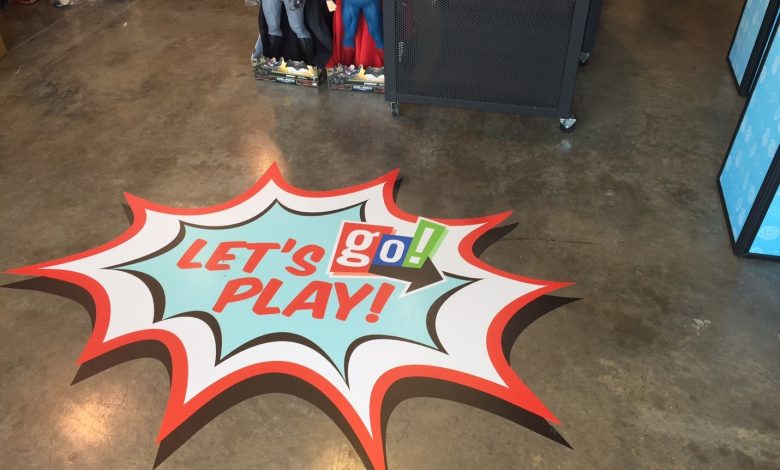
A dramatic “before” and “after” can be captivating. It’s satisfying to see how a space can take on a completely new feel with the ingenuity of design. Walls, windows and floors are surfaces that have untapped potential for aesthetic – and functional – transformation with graphic films.
There are multiple ways to use these substrates for a greater purpose, whether it be with a mural, branding collateral, wayfinding signage or seasonal promotions, with more and more applications for wrap films every day. There are specific practices for each surface that should be followed for optimal results, and this guide will walk through the applications to offer helpful tips for successful transformations.
Windows
Windows and glass are a clear choice for expanding graphics applications but can pose challenges for design and application. Key areas of growing transformation include storefront windows, interior office glass and window graphics on public transportation.
Maintaining natural light and optical clarity is crucial when designing for windows. For installation, the critical first step for any surface, especially glass, is proper cleaning and preparation. For windows, that includes ensuring there is no existing film on the surface or residue left behind.
Tip: To determine if there is existing film, spray water onto the window. If the water beads up, there is a film on the window that needs to be removed. A stainless-steel metal scraper can take off any leftover adhesive or tough grime, and then the glass should be washed with alcohol and a water/soap solution.
Product Selection: The nature of the project, whether to establish privacy in an office, brand a storefront or showcase promotions, will dictate the film best suited for the job. For example, 3Mâ„¢ Controltacâ„¢ Print Film 40c is an inkjet printable film for stunning graphics. Perforated films are ideal for promotional graphics for one-way viewing.
Ultimately, the common theme among window applications is advertising, and using the surface to draw people into the store or reach them on the go. Keep this intent in mind when designing graphics to grab attention.
Walls
Blank walls are prime real estate for the expansion of graphics. Many companies want to create experiential stores that transport customers, solidify their brand messages and build consumer loyalty.
There is increasing demand within industries such as retail, healthcare, hospitality and more to extend branding onto unused wall space and establish the company’s footprint throughout a facility. Not only does this mean an influx of potential new business projects for your shop, but wall wraps and graphics typically cover more square feet and increase the bottom line per project.
Tip: Wall graphics are usually larger scale and may have multiple panels for installation. Bringing a table with you to the job site is helpful for keeping the graphics and tools off the floor and staying organized.
The biggest challenge with walls today is the evolution of paint chemistries. More paint manufacturers are shifting to low-VOC formulas, which can make it difficult for print films to adhere. Similar to windows, proper preparation will determine success later on in the project.
Product Selection: Running an adhesion test with the 3Mâ„¢ Adhesion Test Kit will ensure you choose the right film adhesive for the surface.
A design trend for walls is using graphic films to construct an environment that gives a space a completely new feel. For example, one children’s hospital turned its sterile, white magnetic resonance imaging (MRI) room into a pirate ship with printed graphics. The whimsical scene, including the MRI machine wrapped to look like a cannon, was designed to help kids feel less intimidated by the equipment and more at ease during tests. Using graphics and wrap films to transform how people experience a room is the power of wrapping surfaces like walls.
Floors
There’s no denying that cell phones play a big role in the way we live and interact with our surroundings. They are also one of the primary reasons why floor graphics are rising in popularity. Everyone is looking down at their phones while walking through malls, down the sidewalk and while attending arena events, making floor graphics one of the easiest ways to grab the attention of a passersby.
Tip: There are different considerations for outdoor vs. indoor floor graphics. It is advised to overlap the panels for outdoor graphics as the environmental conditions can cause the film to shrink. Indoor floor graphics don’t need to be overlapped. For both outdoor and indoor floor graphics, the corners should be rounded to eliminate points that can be curled or pulled up.
Product Selection: Keep in mind that floor graphics require a base film and overlaminate with UL certification to ensure slip resistance. Additionally, indoor floor graphics and outdoor sidewalk graphics have different optimal print films.
One floor trend taking over the industry is the use of graphic films to create optical illusions. Designs that appear 3D, such as standing at the edge of a cliff, are successful in making people look twice and even interacting with the installation. This is another way the expansion of wrap installations to areas like sidewalks can completely transform the way someone views a surface.
There’s an incredibly diverse range of surfaces that can be completely transformed with the use of graphic films. From sports arenas to brick-and-mortar storefronts, the opportunities are endless. Knowing how to properly execute designs, no matter the surface, will help grow businesses and build reputations.
Continue your education on window, wall, and floor applications by clicking this link.